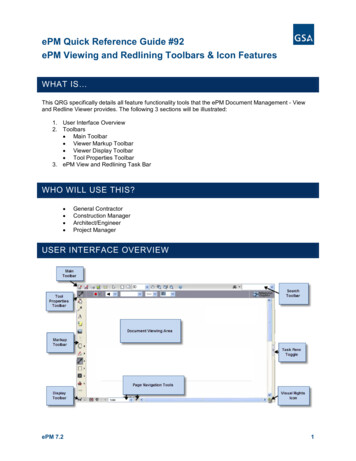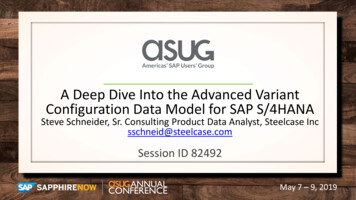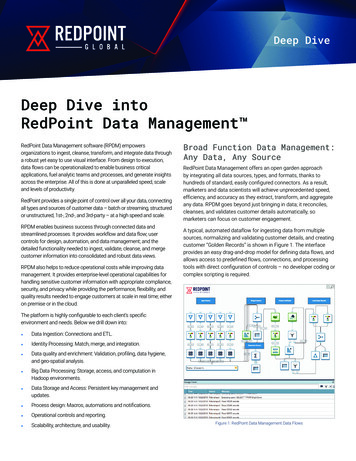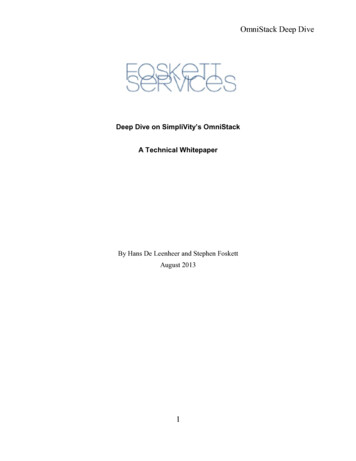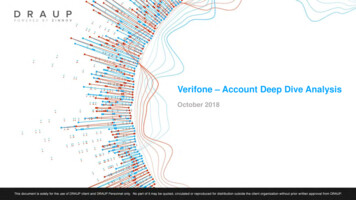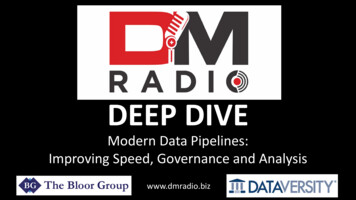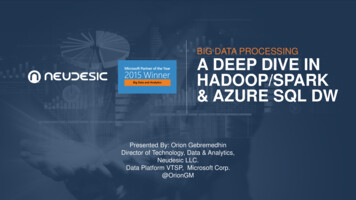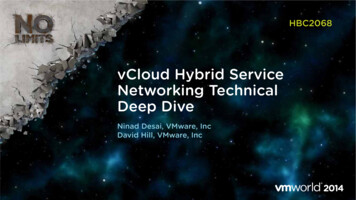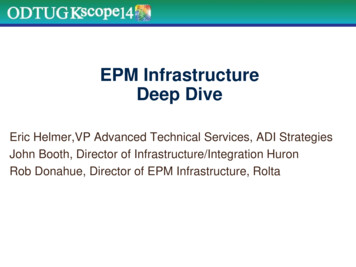
Transcription
EPM InfrastructureDeep DiveEric Helmer,VP Advanced Technical Services, ADI StrategiesJohn Booth, Director of Infrastructure/Integration HuronRob Donahue, Director of EPM Infrastructure, Rolta
Agenda1. First Session – Eric Helmer - 30 mins 11.1.2.x what's new and overall architecture Installation/upgrade tips, tricks, and considerations Patching best practices2. Second Session – John Booth – 30 mins Performance tuning Backup/recovery Disaster recovery3. Third Session – Rob Donahue – 30 mins Health monitoring Troubleshooting Logs and diagnostics4. Q&A - 30 mins
EPMWhat’s New, Installation, PatchingEric HelmerVP Advanced IT services, ADI StrategiesOracle ACE DirectorContact Eric at:ehelmer@adistrategies.comBlog: http://EricHelmer.wordpress.comWeb: www.EricHelmer.comTwitter: @erichelmer
Pre-System 9Separate, Best of Breed Individual SeparateProducts No real single sign-on Individually installed No common look andfeelor portalAnalyzerHFMReportsUserEssbasePlanning
System 9/11Enterprise ClassPlanning Integrated enterprise Complex architecture Seamless to end userWebAnalysisEssbaseSharedServices Single sign-on Same look and feelFinancialReportsHFM
Modern Challenges Mixed Operating Systems, virtualized environments Outsourced IT departments Helpdesk integration, ticket systems, support 3rd party hosting companies Global implementations Formal design review System monitoring High availability/load balancing Disaster recovery Vulnerability testing, port scanning SSL/HTTPS Change Management, versioning systems Firewalls Automation and scheduling software OBIEE integrationEnterprise ClassSolutions needEnterprise ITplanning, design,and transition.IT methodologymust include fullenterprise class rollouts, meeting allCorporate ITchallenges.
Latest VersionsHyperionArchitectureOracle EPM9.3Oracle EPM11.1.0Oracle EPM11.1.1.4OracleArchitectureOracle EPM11.1.2FusionOBIEE 11gFusionODI 11gFusion
Version HistoryCompatibilities11.1.1 - 200811.1.2.0 - 201011.1.2.1 - 2010 Most products are 32-bit Windows Server 2003SP1 and SP2 (32-bit or64-bit) IE 6 and 7, Office 2003and 2007 Intended for a newinstall, but a lot willmigrate No backwardcompatibility Full 64-bit binaries Windows server 2008 R1 IE 7 and 8, Office 2003and 2007 Upgrade path andbackward compatibility 9.2.1, 9.3.3, 11.1.1.3 &11.1.2 Windows server 2008 R2 Office 2010
11.1.2Significantly different - Fusion Weblogic embedded and required Almost 100% 64-bit support (except FDM, Strat Fi, ODI) Significant changes in directory paths and folder organization Support for Server 2008 and IE 8 and FF 3.5, Office 2010 Oracle HTTP server replaces Apache SSL termination at web server support Essbase clustering No more OpenLDAP! Better Logging mechanisms Exalytics Machine
11.1.2.2 Websphere 7.0.0.19 supportMS Office 2010 64-bitFirefox 10.x and IE9Smart View to HSFNo FR Print ServerCompact DeploymentNew HFM and Planning UI (ADF)Calc. Manager replaces HBRStandalone client installers
11.1.2.3 Update ASO native in PlanningFDM EEVertical ClusteringNew Log analysis toolLCM change auditingWorkspace OBIEE integrationLCM more of an end user toolEPM LCM “cloning”IE 10
Types of Upgrades In-place – on top of existing servers Requires Downtime Cannot change Operating System Out-of-place – new hardware Must install new, migrate applications No downtime, cut-over when ready Can refresh hardware and Operating system
UPGRADING
MigrationPostInstallationTraining &Go-Live
The Three Keys to SuccessEstablish the Team and MethodologyA Project ManagerA Project ManagerA Project Manager
Project ManagementMost Solidify a Partnership Between IT and Finance!DesktopAdmins/HelpdeskBusinessApp AdminsSecurityServerAdminsEnd UsersDBAsProjectManagerConsultants
DESIGN GOALSProper IT Design Server sizing Disk systems Memory usage PerformanceReliabilityHigh availabilityBackupsClusteringDisaster Recovery Right sizing Virtualization Load balancingScalability
Inputs to IT ArchitectureUser Population Named, Concurrent Where are the users?Multiple Environments DEV, Test, Training, UAT,PROD, DRMigration Strategy Who? Frequency? QC ProceduresUseUserPopulationProfile How many Planning, HFM,Essbase users? How will end-users accesssystemEnd-userUse PopulationDesktop Admin Rights?UseBackupsPopulation Procedures, backup windows Disaster RecoveryToleranceUse Populationto Downtime High availability design?InternalUse PopulationIT Standards Operating System Helpdesk / Monitoring 3rd Party StandardsSecurityUse PopulationRequirements SSL? Firewalls? External Authentication
Enterprise IT designLinium’s Advanced EPM Hardware Design Services Enterprise Class IT design, best practices, scalability,availability Shift from IT being simply necessary to being a competitiveadvantage and part of the strategic vision and businessdirectionVirtual vs. PhysicalHelpdesk IntegrationIn-House vs. HostingAutomated MonitoringScalabilityMaintainabilityBackup / RecoverySecurity / SSL / HTTPSHigh AvailabilityDisaster Recovery
Database Design Shared Services EPM Architect Business Intelligence Used by Workspace, FR, WA, IR Analytic Administration Services Calculation Manager Essbase Studio Oracle Data Integrator Data Relationship Manager Strategic Finance More for Planning, HFM, FDM, etc.SharedServicesCALCMANEPMArchitectSTUDIOBI PlusODIAdminServicesDRMPlanningPlanningFDMHFM
Pre-InstallationDownloadDocumentation andSoftwareConsultant AccessAccounts, Work AreaCreate neededSystem AccountsDisable UnnecessaryServices, VirusScanningDatabase Client andConnectivity TestingPrepare ServersClean up! Delete all unused objects, users before upgrade!
Installation Process
Migration / Upgrade ObjectsSecurityReportsApplications (i.e.Planning, Essbase,HFM, FDM)DataETL andAutomationBusiness rules toCalc Managerconversion
Go-live / Operational ReadinessParallel close, useracceptance,conference roompilotsMonitoring agentsHelpdesk andticketing systemsSupport procedures,on-call andresponsibilityPerformance testingand tuningDisaster gBusiness continuity,redundancy testingSecurity hardening
Patching Patch Sets (PSU’s) Should be installed in all environments Ie .100, .200, .300 . Patch Set Exception On-off situational only Non round numbers
EPM Tuning, Backup, and DRJohn A. Booth@johnaboothmetavero.com 1.224.545.8820
TuningVirtualMachine OperatingSystemRelationalDatabaseVirtual MachineOperating SystemRelational DatabaseWeb ServerJava ServerApplicationWebServerJavaServerApplication
Tuning: Virtual MachineSize as if were physical machines; disable powersaving in physical machine BIOS#1 performance killer is shared resources Physical Server has VM’s exceeding 2:1 – I prefer closer to 1:1on Analytic Apps e.g. HFM, HSF, Essbase. On very busy(overcommitted) servers more cores can lead to lessperformance On Analytic Apps ensure you have THICK disk provisioning FIXED (Hyper-V 2012) or EAGER ZERO (VMWare)Do not use Hyper-V 2008
Tuning: Operating System Network Settings e.g. Max Ports, Time toReuse Ports, Disable power saving features; CPU, disk, Disable real-time AV scans on analytic datastores e.g. Essbase, HSFConsider impact of port driven AV scans e.g.port 80, 443, 19000, DCOM, all the JVM ports.Recommend you exempt from port scanningWindows: orkerThreads
Tuning: Relational Database Storage speed (HFM, FDM/FDM EE, HPCM)Open Cursors (HFM)Temporary space (HFM/FDM/FDMEE) On SQL Server have one tempdb per core of SQLServer RAM SGA sizing for Oracle % of RAM for SQL Server Number of allowed Connections / SessionsAllow for auto growth by at least 100 MB
Tuning: Web Server Offloading of SSLCompression especially for global deploymentsThreadsTimeouts
Tuning: Java Server (WebLogic) General Tune your minimum / maximum heap sizes Tune stack sizes where appropriate e.g. Planning Timeouts WebLogic Maximum data source connections; see tuningguides Native IO drivers on platforms where applicable 64-bit Solaris platforms including Exalytics as ofJune 2014 deploy with a 32-bit AdminServer whichleads to slow JVM starts
Tuning: Application RA Framework – disable harvester andtransformer when Interactive Reports are notused; broker connection settings to 500, heapsettingsPlanning – OLAP ConnectionsEssbase – DB Settings, Essbase.cfg, opmn.xmlFinancial Management – Registry Settings
Backup and RecoveryScope ProcedureIdentify scopeIdentify procedureImplement procedureTest procedureImplementTestTestTest
Backup and Recovery Backup Production and Non-Production Although non-prod is less critical, it is moreexpensive to perform re-work Vs. restore lost work Data retention Be able to go back 30 days Be able to go back to point in time up to 3 months Be able to go back to individual quarter ends up to12 months O/S, Install user home directory, Registry (Win),Data folders, and Application Installation
Backup and Recovery HOT vs COLD; HOT is non-invasive DO test your backup strategy – there are manysad stories about the backup that doesn’t workNEVER: Restore Shared Services DB to anotherenvironmentHINT: LCM for shared services role provisioning as wellas granular items you may want to restore with minimal ITinvolvement e.g. Calcs, Rules, Grids, Forms, Reports,
Backup and RecoveryAreaTechniqueBase ApplicationFile system backups (and registry for Windows)VM’sSnapshots/point in time of full machineFoundationLCM exports of ROLE securityBIPlusRelational and File Backups (RM1)EssbaseFile backup for key artifacts: *.sec, *.otl, *.csc, *.rul,*.rep, Data Options:1. Full Archive Transactions2. Exports of data e.g. Calc Data Export, Level 03. PAGE/INDEX filesFDMRelational and File Backups (FDMData)HFMRelational BackupsHSFFile Backups (HSFData)
Disaster RecoveryApplicationCriticality ntTestExerciseIdentify Application CriticalityIdentify Recovery Point Objective (RPO)Implement Recovery Time Objective (RTO)Test procedure
Disaster Recovery: Good Practices Don’t put your eggs in one basket: EnsureDisaster Recovery Center is in location leastlikely to be affected by an event in your primarydata centerIf it’s not tested, don’t count on it: Yearlyrecovery test of critical applications
Disaster Recovery: Options Maintain production in two data centers in syncat all timesRestore to a dedicated environmentRestore over a QA/TEST environmentFull restore to an isolated network (VLAN) Identical to production in every sense; requiresduplicated architecture for whole environment e.g.AD/LDAP, DNS, networks, Usually the least amount of work for the applicationteams
Disaster Recovery: Terms Application Criticality – What critical processesare impacted when my system is down?Recovery Point Objective (RPO) – amount ofdata lostRecovery Time Objective (RTO) – time torecover from last recovery point
ResourcesOracle EPM Tuning GuideEPM 11.1.2.2 and 11.1.2.3 Infrastructure Tuning Guide (Doc ID 1595920.1)Oracle VM-3 10GbE Network Performance rage/vm/ovm3-10gbe-perf-1900032.pdfVirtually all the timehttps://blogs.oracle.com/jsavit/VMWare Tuning for latency sensitive ance Tuning Guidelines for Hyper-V 2012 (Windows Server 2012 /hardware/dn529133.aspx11.1.2.3 EPM Deploy and Installation Documentationhttp://docs.oracle.com/cd/E40248 01/nav/portal 1.htm
Troubleshooting EPMRob 37.5428
Types of Issues Issues can be categorized into 2 buckets Isolated – A problem that occurred once i.e. Workspace crashed on Monday Systemic – A problem that continually occurs with some frequency i.e. Planning crashes regularly during close cyclesThere is not a lot of point in trying to find the root cause of anisolated issue It’s difficult and time consuming to try and often the effort yieldslittle information Just walk away Systemic issues need to have some root cause analysisdone It is important to determine the cause of the issue to prevent itfrom continuing to happen Restarting Planning 3 times a week during close is not a resolution
Resolving an Issue Once the issue has been triaged & the scope andimpact is known one can go about the effort trying toresolve the issue The process of troubleshooting is more of an art than askill that can be taught Like anything however there are principles which canbe learned and applied when the need arisesThe goal of troubleshooting is not to determine ‘why’so much as to find a resolution to the issue
Resolving an Issue: What you need to know In order to be able to effectively troubleshoot anissue in an Oracle EPM environment one must havea grasp of: Basic architecture of the products deployed in theenvironment Understanding of the where’s, what’s & how’s the Web,Application & Data tiers behaveUnderstanding of the inter-dependencies for the applications &tiers Location of log & property files Remember not just the Oracle EPM logs are relevant. The WebApplication server or Event logs might contain importantinformation Note: Log Locations changed beginning with 11.1.2 & are groupedunder EPM MIDDLEWARE HOME /user projects/ epm systemN /diagnostics/logsBasic understanding of Java Web Application servers & HTTPprocessing
Oracle EPM 11 Architecture
Troubleshooting 101 Locate the problem Example: A user says that they cannot run reports This is a pretty generic statement so in order to help steerthe troubleshooting the general source of the issue needsto be
ODI STUDIO CALCMAN Database Design . Pre-Installation Download Documentation and Software Consultant Access Accounts, Work Area Create needed System Accounts Disable Unnecessary Services, Virus Scanning Database Client and Connectivity Testing Prepare Servers Clean up! Delete all unused objects, users before upgrade! Installation Process . Migration / Upgrade Objects Security
